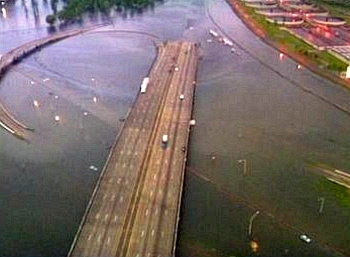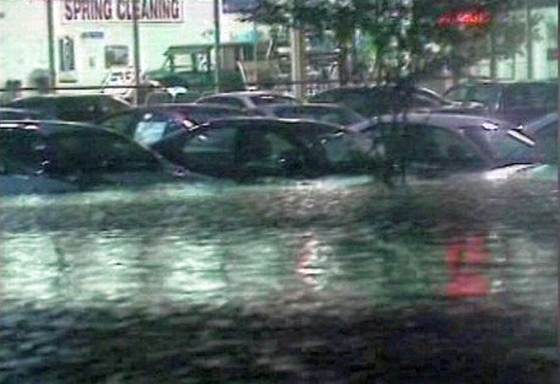|
Today in New Orleans History |
|
|
May 8


 Labeling the May 1995 flood event in southeastern Louisiana and southern Mississippi
"memorable" and "paralyzing" may be an understatement in regard to the episode witnessed by residents
of the region. Beside the very heavy rainfall, severe weather occurred with two confirmed tornadoes (one F1 and one F2
as defined by Fujita's Tornado Scale [Fujita 1971]) in Louisiana. Indeed, the event was historic, catastrophic, and devastating
from both a meteorological and human perspective. The event lasted about 40 hr, flooding over 44,000 homes, inundating countless roads, and impacting
over one million residents. Damage assessments exceeded a staggering three billion dollars. Tragically, seven deaths occurred--six
within the metropolitan New Orleans area and one in Harrison County, Mississippi. With extensive damage and scores of
people needing immediate aid, President Clinton declared seven southeastern Louisiana parishes and four southern Mississippi
counties disaster areas, qualifying them for federal assistance. Subsequently, the National Guard was activated to assist
with evacuation and rescue efforts. In comparison, Hurricane Andrew's 1992 Louisiana impact tallied $1.76 billion,
eight directly related deaths, 18,247 homes damaged, and 36 parishes declared federal disaster areas (Storm Data, August
1992). In the wake of the flooding, community response was extraordinary. Numerous organizations from both states and
around the country donated food, clothing, financial assistance, and household goods to flood victims, many of whom had
lost all their personal possessions. This catastrophic flood paralyzed many parishes and
counties in southern Louisiana and southeastern Mississippi. The total event lasted about 40 hr. Virtually all roads were
inundated or impassable during the height of the event, especially in the New Orleans metropolitan area and in the Covington
to Slidell area of south St. Tammany Parish. Portions of Interstate 12 between Covington and Slidell were under water.
Homes receiving water damage included 18,000 in New Orleans, 7,000 in Slidell, 15,000 in Jefferson Parish, and 3,500 in
St. Charles Parish in Louisiana, and over 1,000 homes in southeastern Mississippi. Well over a million residents were affected
in some manner by the heavy rain and flooding. Seven parishes in Louisiana and four counties in southeastern Mississippi
were declared disaster areas. Seven deaths were attributed to flooding. Six of the deaths
occurred in the metropolitan New Orleans area. Five of these deaths were males ranging in age from 27 to 56 and occurred
on May 9. The sixth, an infant, was found floating on water toward a drainage pump on May 11. There was one death, a female,
in Slidell that occurred on May 10; however, her death was likely attributed to a traffic accident. The seventh death occurred
in Harrison County, Mississippi, when a 32-year-old male in his vehicle was swept away by the swollen Wolf River north of
Long Beach. Photos from WWL-TV.  

To receive an update for each day in New Orleans
history, join our facebook page
- Today in New Orleans History
Tweet
Alexander Allison photo of Tulane Stadium--near front entrance gate for West Side reserved seat boxes, May 8, 1954. Lord Beaconsfield Landry, physician, civic leader and soloist, was born on March 11, 1878 at Donaldsonville,
Louisiana. His father, Pierre Landry, was the first Black Mayor of Donaldsonville. Lord Beaconsfield received his elementary
education in Donaldsonville and later completed high school at Gilbert Academy in Baldwin, Louisiana. He received a B. A.
in 1902 from Fisk University where he was a member of the Fisk Jubilee Singers. He taught school until 1904 when he enrolled
in Meharry Medical College. He received his M. D. degree in 1908 and returned to New Orleans to practice medicine in Algiers.
Dr. Landry, always interested in helping the less fortunate, began a column "How to Keep Well" in the Louisiana
Weekly newspaper on May 8, 1928. He operated a free clinic for the poor people of Algiers. He also directed
the Osceola Five, an all male vocal group that specialized in Black cultural music for educational and religious programs.
On January 23, 1934, Dr. Landry died of blood poisoning. He was originally buried in Mount Olivet Cemetery, but later his
remains were reburied in Nashville.(NOPL)
|
|
|

To receive an update for each day in New Orleans history,
join our facebook page - Today in New
Orleans History.
Analytics |



